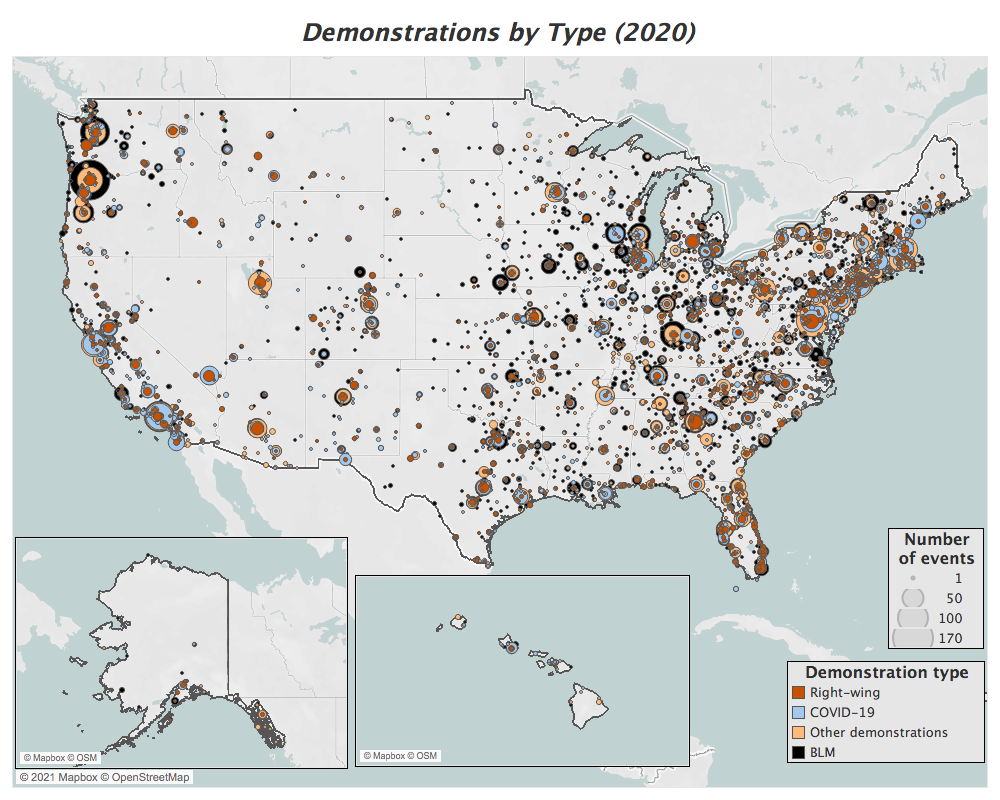5 February 2021: New US Crisis Monitor data extend ACLED’s coverage of political violence and demonstration activity in the United States to all of 2020. Over the course of the year, the project recorded more than 22,900 political violence, demonstration, and strategic development events across the country.1 See the US Crisis Monitor FAQs and the US methodology brief for more information about coding methodology and definitions.
ACLED and the Bridging Divides Initiative (BDI) at Princeton University launched the US Crisis Monitor last summer to provide the public with real-time data and analysis on political violence. After tracking key trends and risk factors before, during, and after the 2020 election, this update marks the project’s final data release. With over a full year of coverage, US data will now be added to the main ACLED dataset, bringing this special project to a close. ACLED will continue collecting data on political violence and demonstration activity in the US, with regular weekly updates and analysis. All data will remain freely accessible through the ACLED export tool, curated files, global dashboard, and API. Princeton BDI will continue to provide public and custom ecosystem, trends, and risk mapping, as well as issue briefs, timely analysis, and other resources for communities working to mitigate conflict in the US.
Key Trends: 2020
The Black Lives Matter Movement
Sparked by the police killing of George Floyd in May, the latest wave of protests associated with the Black Lives Matter (BLM) movement accounts for 47% of all demonstrations in the US last year.2This does not include other social justice demonstrations; the percentage would be even higher if social justice demonstrations that did not explicitly cite BLM as a driver were included.
- ACLED records more than 10,330 demonstrations associated with the BLM movement across more than 2,730 locations in all 50 states and Washington, DC
- States with the most events: California (1,151); New York (615); Florida (487); Illinois (430); Texas (425)
- The vast majority of these events — 94% — involved no violent or destructive activity
- Nevertheless, over 9% of all BLM-linked demonstrations — or nearly one in 10 events — were met with intervention by police or other authorities, compared to just 4% of right-wing demonstrations3Right-wing demonstrations encompass a range of distinct but interrelated movements, including: pro-Trump or anti-Biden rallies, as well as events that involve or express support for the Republican Party; pro-police demonstrations, such as those that involve supporters of the ‘Back the Blue’ or ‘Blue Lives Matter’ movements, which often organize as counter-protests against demonstrations associated with the BLM movement; demonstrations that involve QAnon conspiracy theory supporters or protesters associated with the ‘Save Our Children’ movement; protests that involve members of right-wing militias or street movements either actively participating or standing by to ‘keep the peace’ during an event; and ‘Stop the Steal’ demonstrations, which have specifically emerged in the post-election period. For more, see this recent ACLED report.
- When responding to BLM-linked demonstrations, authorities used force4Use of force ranges from firing less-lethal weapons like tear gas and rubber bullets to beating demonstrators with batons. more than 51% of the time, compared to just 33% for right-wing demonstrations
- For more on disparate law enforcement response to different protests, see this report
Right-Wing Mobilization and Militia Activity
While the BLM movement accounts for the majority of demonstration activity in 2020, ACLED records an increase in right-wing demonstrations over the course of the year, and especially in the weeks following the election, with armed militia groups taking an enlarged role in right-wing mobilization ahead of the Capitol riot in January 2021.
- Over 2,350 right-wing demonstrations took place across more than 1,070 locations in all 50 states and Washington, DC
- States with the most events: California (229); Florida (165); New York (140); Pennsylvania (137); Texas (135)
- The year started with a spike in right-wing demonstrations against lockdown restrictions imposed in response to the COVID-19 pandemic. During the summer, right-wing activity largely shifted to more indirect involvement in demonstrations associated with the BLM movement, where armed militia members maintained a presence to purportedly ‘keep the peace.’ Following the election, right-wing events again surged with a spike in activity associated with the ‘Stop the Steal’ movement
- Militarized right-wing social movements like armed militia groups have been involved in 11% of all right-wing demonstrations, with this figure rising to 20% following the election, leading up to the Capitol riot. This includes groups such as the Proud Boys, the Three Percenters, and the American Contingency, among others. For more on right-wing militias, see this report
- ACLED tracked 148 right-wing armed groups and militarized social movements active in the US last year
The COVID-19 Pandemic
The health crisis triggered substantial unrest amid the devastating economic downturn and deep political divisions over an appropriate response.
- Over 3,990 demonstrations directly related to the pandemic were recorded across more than 1,210 locations in all 50 states and Washington, DC
- States with the most events: California (708); New York (321); Florida (192); Texas (163); Pennsylvania (158)

A US-based 501(c)(3) non-profit organization established in 2014, ACLED is the highest quality and most widely used real-time data and analysis source on political violence and demonstrations around the world.
Princeton’s Bridging Divides Initiative (BDI) is a non-partisan research initiative that tracks and counters political violence in the United States. BDI’s goal is to build a foundation of trust and cooperation in communities to bridge the divides facing the nation.
If you would like to use ACLED data and analysis, please review ACLED’s Terms of Use & Attribution Policy. For more information about ACLED methodology, please check the US methodology brief as well as the ACLED Resource Library.
For interview requests and press inquiries, please contact: Sam Jones, ACLED Senior Communications Manager and Nayyera Haq, BDI Communications Advisor






